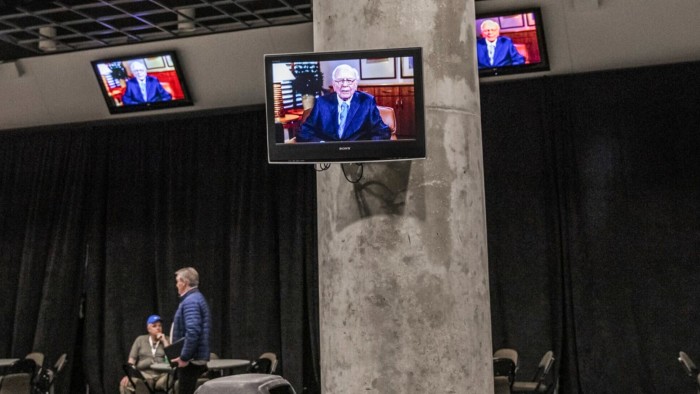Hedge funds are bouncing back — but are they better than a simple tracker?


Roula Khalaf, Editor of the FT, selects her favourite stories in this weekly newsletter.
When Warren Buffett described hedge fund managers as “an elite crew, loaded with brains, adrenaline and confidence”, it was not a recommendation.
In fact, his 2018 letter to Berkshire Hathaway shareholders, in which he used the phrase, was meant to drive a stake through the heart of the hedge-fund industry. This was the year he revealed the results of his bet from a decade earlier that the S&P 500 would trounce a portfolio of hedge funds over a 10-year period: it did, returning 126 per cent. The best of the five funds of hedge funds picked for the other side of the bet managed just 88 per cent over the decade, and the worst returned a dreadful 3 per cent.
These hedge fund managers earned “staggering sums” in fees over the period, Buffett wrote. “While this group prospered, however, many of their investors experienced a lost decade.” What, readers were meant to wonder, is the point of all these pricey and complicated trading strategies if there are such low odds of beating money socked away in an equity market tracker fund that has fees of a fraction of a penny on the dollar? It was already a question being asked by the wealthy individuals who were first to back hedge funds in the 1980s and 1990s, and by the institutional investors who piled in later. Data from HFR, which has been tracking the industry for more than 30 years, shows that annual outflows have been more or less relentless since 2016.
But Buffett failed to nail the coffin shut. Hedge funds are showing signs of life this year. The industry recorded net inflows in the first quarter, with managers large and small taking in new money as banks teetered and fear of recession stalked the markets.
HFR even sees this is an auspicious time to market a new hedge fund index targeted at wealthy individuals in the US.
Earlier this year, it launched the HFRI 400 (US), which is designed as an “investible” index, meaning HFR hopes a wealth manager will build an investment product that tracks the index. To make that practical, the index only includes funds appropriate for investors who pay taxes in the US and which are currently open to taking new money.
The company already publishes the HFRI 500, a slightly broader index aimed at institutional investors who can invest in hedge fund managers’ offshore vehicles. Both benchmarks are designed to offer the full range of hedge fund types, from equity long/short strategies, through macro funds to volatility trading, weighted roughly according to their size within the industry as a whole. The wealth manager Abrdn offers investment products that track the HFRI 500, and HFR is looking for a similar partner to sell an HFRI 400 product to wealthy Americans who need an onshore version.
What might be the appeal? This year’s hedge-fund revival, I think, rests on the back of a dismal year for investors in 2022. Bonds and equities, which are meant to balance each other out in a classic portfolio, both finished deeply in the red. Rising interest rates dinged both the value of fixed-income investments and the fast-growing tech companies that dominate the stock market. A traditional 60/40 portfolio of US equities and bonds offered by Vanguard was down 16 per cent — the kind of loss not seen for 50 years — making the hedge fund managers’ pitch of “uncorrelated returns” look seductive for the first time in a long while.
At the same time, there has been a general loss of confidence in the other kinds of alternative investments beloved of wealthy savers. The private equity model of leveraged buyouts looks questionable in a high-interest-rate environment. Venture capital funds may not yet have had to fess up to the collapse in value of their existing investments, but start-ups are in a world of pain. Cryptocurrency might not be an asset class after all.
In this environment, perhaps it is inevitable that hedge funds will get another look-in. The HFRI 400 is pitched as a solution to some of the practical hurdles for investors dabbling in the sector, from the time and expense of stress testing individual hedge funds to the anxiety of worrying your individual hedge fund pick will be a dud. If in doubt, buy them all!
So where does that leave the existential questions raised by Buffett? Yes, hedge funds have tended to shield their investors from the worst of a downturn in equities in the stock market’s worst years, but at the cost of dramatically underperforming over the long run.
For wealthy investors tempted by last year’s rout to look again at the sector, it is worth perusing HFR’s own statistics. Using backtested data for the HFRI 500, hedge funds continue to be a clear laggard on a long view, returning 61 per cent in the 10 years to December 2022, versus 227 per cent for the S&P 500. Even that Vanguard 60/40 portfolio beat the hedge fund index seven years out of the 10 and returned 79 per cent over the decade.
How is 2023 shaping up? As of May 31, hedge funds were flat, year to date. US bonds were up 2.5 per cent. The S&P 500 had returned 9.6 per cent. Perhaps it is time for Buffett to lay another bet.
Stephen Foley is the FT’s US accounting editor. Follow him on Twitter @StephenFoley
This article is part of FT Wealth, a section providing in-depth coverage of philanthropy, entrepreneurs, family offices, as well as alternative and impact investment
Comments